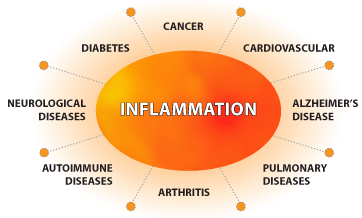If you’ve been following the Blue Heron Health News website for a while or reading up on natural health on other media, you’ve been bombarded with the importance of inflammation and how it’s causing many of the major diseases we face.
Diseases like:

|
…just to name a few.
But when you try to figure out what exactly inflammation is and how exactly it causes these diseases, you don’t get many answers. So in this article I’ll try to give you as clear an answer as possible on this complicated issue.
You see, inflammation is in essence, an organism’s first attempt to heal itself once it senses injury or invasions.
 The most visual example is if you hit your finger with a hammer and then watch it swell up in two minutes.
The most visual example is if you hit your finger with a hammer and then watch it swell up in two minutes.
Swelling (due to fluid rushing into the injured area) is, however, only one of five signs of inflammation. The others are:
– Pain (due to stimulation of nerve endings),
– Redness,
– Heat (due to increased blood flow to the injured area),
– Immobility / loss of function (due to swelling and a neurological reflex to prevent further damage to the injured tissue).
As your finger swells up, you feel pain and pressure. It becomes red and hot and you have a hard time moving it. Depending on the weight of the hammer and the length of the healing process, the inflammation can last for hours or days. But once you feel the pressure release, you know your finger is going to feel just fine.
What you don’t see or feel are the millions of immune blood cells rushing into the area to restore injured tissues and fight any foreign invaders (like bacteria or splinters).
The fact is, we could not live without inflammation. Without it wounds and infections would never heal and organs would progressively fade into destruction.
So what’s the issue then, you may ask.
You see, it’s when inflammation becomes chronic, it’s destructive and contributes to major and minor diseases.
Chronic inflammation happens when this ongoing mechanism doesn’t stop once it has served its purpose. Or when the immune system perceives things as threats, creating an inflammation response. Or, even worse, when the immune system begins to attack its own healthy organism.
Chronic inflammation leads to a change in the types of cells located around the area of inflammation. This leads to a chronic circle of healing and destruction at the same time.
One very obvious type of chronic inflammation is an allergic reaction. Seemingly safe things like cat hair are detected by the body as a foreign invader. The immune system is trigged and the inflammation response is created where the “foreign attack” (the cat hair) stimulated the response.
In the case of allergies, once the foreign invader (the cat) is removed, the immune system quickly returns to normal and the inflammation disappears.
Then we have the longer lasting chronic inflammation.
Sometimes, for example, immune systems detect joint cartilage cells as foreign invasion and begin to attack their own organism. To recover, the inflammation response is triggered again. So the body attacks and restores at the same time. This example leads to arthritis.
The inflammation reaction can ‘mistakenly’ be triggered anywhere in the body. If your immune system begins attacking your pancreas, you’ll develop type 2 diabetes.
It’s like your body is fighting a civil war against itself and nobody knows for sure why and how it began.
What can be even more serious is that while the body is busy fighting itself, it may not have enough forces to battle real threats like the flu and other diseases, leaving us very vulnerable.
By now you’ve probably realized the solution is not simple. We can’t just get rid of all inflammation because we need it for our survival. Instead we need a diplomatic solution.
Like in most wars, the fault doesn’t lie with the soldiers (the white blood cells) doing the fighting but rather among the governing authorities. For some reason, the brain is sending out message to the immune system to attack its own forces.
So in dealing with chronic inflammation, we need to avoid anything that stimulates unnecessary inflammation attacks and increase everything that helps monitor the stimulation system. This helps your brain detect what is the real danger and where it’s overreacting.
This is best done with diet changes.
When we talk about anti-inflammatory diet, we’re not talking about diet that suppresses the inflammatory response (although that may be needed in the beginning) but rather diet that helps to monitor and manage inflammation.
By far, the number one thing on the list to be able to monitor the inflammation reaction is to increase your Omega-3 fat intake. This healthy fat suppresses the inflammation response temporarily, giving your system time to realize if the threat is legitimate or not.
 Fish is the best source of Omega-3 but Flax seed is also a great source. Since the body seems to have an easier time processing Omega-3 fats from fish, you’ll have to take up to three times more Omega-3 if you opt for vegan selections.
Fish is the best source of Omega-3 but Flax seed is also a great source. Since the body seems to have an easier time processing Omega-3 fats from fish, you’ll have to take up to three times more Omega-3 if you opt for vegan selections.
Pretty much all kinds of berries have been shown to help monitor the inflammation response.
Processed sugar and corn syrup are probably the worst kind of inflammation triggers. They simulate the protein your body sends out naturally to trigger a healthy inflammation response. So when you consume sugar, your body is loaded with warfare banners. And if there is nobody else to fight, it fights itself.
Trans fats and other highly heated and processed foods plus chemicals added to most processed food you find in fast food places and supermarkets work in similar ways as sugar to ‘confuse’ the inflammation response.
Finally, stress is one of the major players in triggering unnecessary inflammation responses. Relaxing and taking a load off will do wonders in dealing with any chronic diseases.
For more info on how to tackle inflammation and win, check out:
Our all natural type 2 diabetes program…
Or
Our 21-day plan to overcome arthritis naturally…
And PLEASE don’t forget to leave your comment below.

 Overcoming IBD
Overcoming IBD Multiple Sclerosis
Multiple Sclerosis Banishing Bronchitis
Banishing Bronchitis Gum Disease Gone
Gum Disease Gone Overcoming Onychomycosis
Overcoming Onychomycosis Neuropathy No More
Neuropathy No More The Prostate Protocol
The Prostate Protocol Brain Booster
Brain Booster
 Ironbound
Ironbound
 Solution for Shingles
Solution for Shingles
 The Bone Density Solution
The Bone Density Solution
 The Ultimate Healing Protocol
The Ultimate Healing Protocol
 The Parkinson's Protocol
The Parkinson's Protocol
 The Chronic Kidney Disease Solution
The Chronic Kidney Disease Solution
 Overthrowing Anxiety
Overthrowing Anxiety The Fatty Liver Solution
The Fatty Liver Solution The Hypothyroidism Solution
The Hypothyroidism Solution
 The End of Gout
The End of Gout The Blood Pressure Program
The Blood Pressure Program
 The Oxigized Cholesterol Strategy
The Oxigized Cholesterol Strategy
 Stop Snoring And Sleep Apnea Program
Stop Snoring And Sleep Apnea Program
 The Arthritis Strategy
The Arthritis Strategy The Vertigo & Dizziness Program
The Vertigo & Dizziness Program The 3-Step Diabetes Strategy
The 3-Step Diabetes Strategy Hemorrhoids Healing Protocol
Hemorrhoids Healing Protocol The Erectile Dysfunction Master
The Erectile Dysfunction Master Weight Loss Breeze
Weight Loss Breeze The IBS Program
The IBS Program The Insomnia Program
The Insomnia Program The Migraine and Headache Program
The Migraine and Headache Program The Neck Pain Solution
The Neck Pain Solution The Menopause Solution
The Menopause Solution The Ejaculation Master
The Ejaculation Master The TMJ Solution
The TMJ Solution The Acid Reflux Solution
The Acid Reflux Solution The Fibromyalgia Solution
The Fibromyalgia Solution The Psoriasis Strategy
The Psoriasis Strategy
A very good article and quite educative with all the right information. Bravo!!!
What about nuts for Omega Three's?
A very informative and interesting article.
good morning Blue Heron News:
I just experienced after 81 years of life my first attack of gout. Talk about inflammation. WOW. In your article, I do not see any discussion that the role of electrons moving about/within the molecules of human cells. In trying to understand, in my case where gout starts, the lit so far does outlines, what to omit from your food supply. However, a close look at what they are suggest to omit seems to most of the foods of a VEGAN Diet. your thoughts would be interesting.
At last!!! The implications of the importance of the effects of diet upon our well being and vulnerabilities is being taken seriously and studied
in some areas. In U.K. we have a programme “Food Hospital” on t.v. showing the beneficial effects which diet changes can bring about to correct at least skin disorders. I await further programmes with keen interest
May your own researches go from strength to strength.
Great information
I think it will help millions
keep up the good work
What kinds of fish are best?
So, the key is to keep your immune system heathy with a good diet. I already take three flax oil solfgels a day. 1000 mg each.
marilyn
A very informative article. indeed, Omega 3 found in fish and flax seeds certainly helps to relieve inflammation.
Wonderful comments on what had been such a ‘fluffy’ area of concern for me. Very clear and well written – thank you.
2 other points;-
1 – I wish I still lived in the UK as the Food Hospital sounds very interesting indeed, most us us could use a change in diet – but just dont know where to start.
2 – I hope I am not breaking any rules here – but wondered if you, or anyone has any comments on this product??
Did you know that if you google “INFLAMMATION” every single disease known to man pretty much will come up!!
Did you know that there is NOTHING on the planet that is 100% all natural with clinical studies that will reduce inflammatory markers in the body at a pharmaceutical level?……UNTIL NOW!!! = evolv LIMITLESS is the name of the product. Any information/comments on this product? It seems to be brand new on the market and wondered if it was worht a try?? Thank you all 🙂
this is no doubt an exellent Article, also very good points as to some of the main staples one needs to change in a diet but, get everyone to drink high Alkaline, Antioxidant, Mineral charged, Microclustered, Active Hydrogenated, ionized, restuctured Water, from a Kangen Water Ionizer, give your body what it needs and it will correct many Health Problems, including Diabetes.Change your Water, change your Health.
would drinking "hard" rural water from a well do the same thing?
a great explanation.
Mr. Goodman,
With diabetes, can you comment on having them as a dialysis patient? Is it good or bad for them? Thank you.
good one
Me and my friend are both males over 60 and recently he told me how he cured his frequent nightly trips to bathroom. He was drinking a brew made of oak leaves. I tried it too,and immediately noticed other effects, like constant cough and burning sensation in my chest gone. Also my arthritic pain in my joints improved. It could be worth following up. Milan.
thanks for a very informative article of Blue Heron,i really am impressed
Thanks this was really very informative,keep up the good work :o)
The part about attacking the pancreas….I think you mean Type 1 diabetes not type 2.